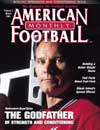AMERICAN FOOTBALL MONTHLY THE #1 RESOURCE FOR FOOTBALL COACHES
Article CategoriesAFM Magazine
|
The Big Squeezeby: Joe Hampton© More from this issue ONE OF THE MOST DIFFICULT times to get a football player into the weight room is during the rigorous two-a-day practice sessions before the start of each football season. During this time the athlete's body is pushed to the limits of exhaustion. It's a time of major concern to most strength and conditioning coaches and athletic trainers because of the chance of overuse/overwork muscle strains and pulls that can occur. During this time the question arises as to what would be the best way to put strength training in the equation. Obviously, there are numerous methods to choose from. We feel circuit training may be the best way to strength train during the pre-season. Our No. 1 objective when developing our pre-season strength training program has always been to give the athlete ample time to recover between the morni....The full article can only be seen by subscribers. Subscribe today!
|
|
|||||||
| HOME |
MAGAZINE |
SUBSCRIBE | ONLINE COLUMNISTS | COACHING VIDEOS |
Copyright 2025, AmericanFootballMonthly.com
All Rights Reserved





